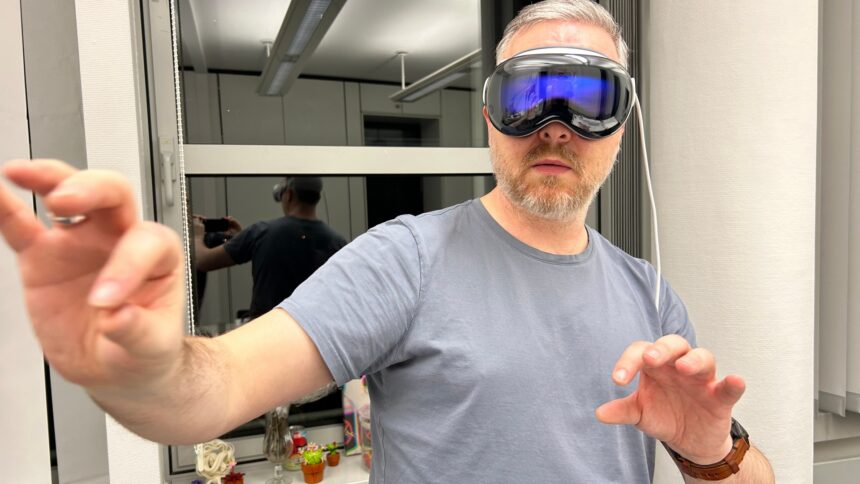
Does the Apple Vision Pro represent an XR breakthrough or is it merely a pricey advanced gadget? Our review uncovers the pros and cons of this VR/AR headset.
The Apple Vision Pro receives both praise and criticism. Multiple magazines have published extensive reviews, sometimes spanning tens of thousands of words, discussing this VR/AR headset. However, is it truly just another headset?
Thanks to the fantastic colleagues at heise online, I was able to check out how the supposed “spatial computing innovation” from Cupertino really performs.
Disclaimer: This review is subjective, as is the case with all evaluations of VR headsets. Users may have varying perceptions of these devices. Any details omitted due to time constraints during testing may be included in future updates.
In summary, this is a review of Apple Vision Pro.
The XR headset, Apple Vision Pro, is remarkable for its exceptional image quality and ease of use. The incorporation of hand and eye-tracking, including in the pass-through mode, is a commendable accomplishment.
The Vision Pro, although expensive, does not provide sufficient content to justify its steep cost. Moreover, it primarily serves as a platform for showcasing 2D content with limited 3D or depth features. Ultimately, this falls short of meeting the expectations of a company aiming to innovate and revolutionize an established industry.
The Apple Vision Pro takes us closer to an immersive future, although it still has a long way to go before being truly professional.
On the objective side:
The exceptional resolution of more than 4K per eye is remarkable, providing outstanding image clarity that is typically associated with PC VR headsets such as Varjo or Pimax.
Field of View: Visibly smaller than the Quest 3.
Passthrough: The quality depends heavily on the lighting, but generally offers a good and, above all, latency-free view of the real environment; however, motion blur is a problem.
Hand-tracking: Extremely precise and lag-free, it represents a new paradigm of interaction in combination with perfect eye-tracking, but suffers from lagging during fast movements.
Controllers: There are no VR controllers, which makes faster games almost unplayable.
The implementation of the Mac connection is done effectively, but the current functioning is quite laughable.
The user’s subjective factors can vary significantly.
The headset’s weight distribution is primarily on the front, causing pressure on the cheekbones and resulting in discomfort, especially when used for a long period of time.
The sound produced by the speakers built into the device is of high quality and has a strong presence.
If you possess the following qualities, the Vision Pro is suitable for you:
- value excellent image quality,
- prefer intuitive and precise hand- and eye-tracking
- want good pass-through quality
- I would like to primarily use the headset for entertainment purposes and presentations, such as design and visualization.
- I possess a substantial amount of money available for expenditure.
The Vision Pro is less suitable for you if you …
- need perfect pass-through,
- are looking for a lot of immersive and productively coordinated content,
- expect a range of excellent AR experiences,
- VR gaming is your primary use case,
- do not want to pay such a steep cost for an XR headset.
- want a comfortable XR headset and,
- Wearing glasses and utilizing contact lenses is not a possibility.
Setup, Configuration, IPD, Eye-tracking, Hand-tracking, VR Controller
I was unable to assess the configuration of the Vision Pro in my experiment since the VR/AR headset had already been set up. The interpupillary distance (IPD) is adjusted automatically when I wear the AVP. The eye tracking setup is a separate process that can be performed again whenever necessary, particularly when sharing the Vision Pro with others.
Eye-tracking was highly effective in accurately selecting menu items and other interactive elements. However, in scenarios with numerous interaction elements, like when using the Safari browser to watch a YouTube video, there is persistent and bothersome unintended highlighting.
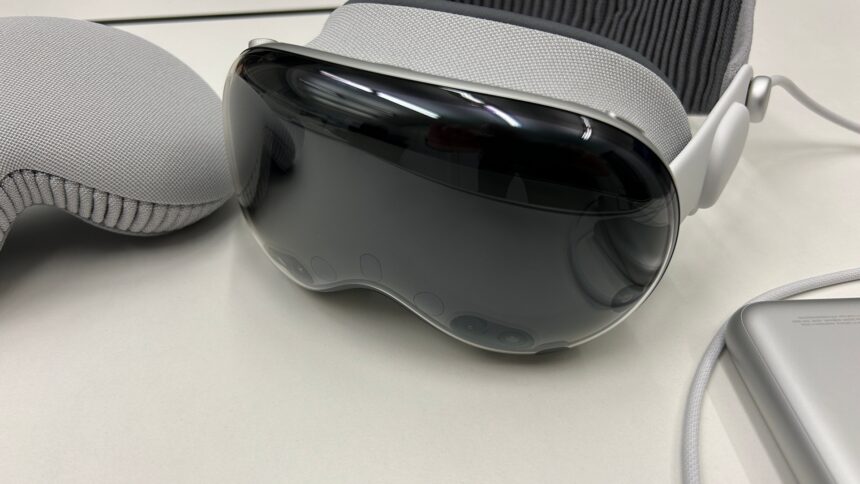
The Apple Vision Pro includes a front protective cover and an external battery.
Vision Pro uses hand tracking in combination with eye-tracking as the operating method and does not rely on VR controllers at all. Hand-tracking is absolutely precise and completely lag-free, making it very intuitive and comfortable to use. It’s a real pleasure to scroll through menus with your hands, look at interaction elements, and then perform an action with a quick pinch gesture (bringing your index finger and thumb together). For me, this is currently the XR’s master class in usability.
Nevertheless, there are certain drawbacks to hand-tracking. For instance, when engaging in fast-paced activities like Fruit Ninja or Synth Riders, there is noticeable lag in hand movements, rendering it impractical for action-packed games. While using a connected Xbox controller may potentially offer a solution for tabletop games like Moss 2 in AVP’s gaming division, it is uncertain whether this possibility will materialize.
Highly accurate hand-tracking also has a significant disadvantage – unintentional input happens frequently. As mentioned earlier, eye tracking consistently identifies an area of interaction, even during movie-watching. If I happen to bring my fingers together at the wrong time, it becomes effortless to unintentionally pause the movie or skip to a different part. I need to be cautious about avoiding a finger gesture that the AVP might misinterpret as a pinch.
I am able to effectively use the virtual keyboard for typing, however, it can be slow and exhausting in the long term due to its one-finger typing system. To alleviate this, I have the option to connect a Bluetooth keyboard for more extensive and frequent typing.
Apple Vision Pro: Resolution, colors, image & field of view
The Vision Pro offers an incredibly impressive image quality. It has a resolution of more than 4K per eye and a standard refresh rate of 90Hz, resulting in a clear and smooth image. The colors are vibrant and the OLED displays offer a great contrast ratio.
The special lenses of the Vision Pro provide excellent clarity from one side to the other, although there are more reflections inside compared to the Quest 3. This is particularly noticeable in scenes with high contrast, but I easily adapted to it.
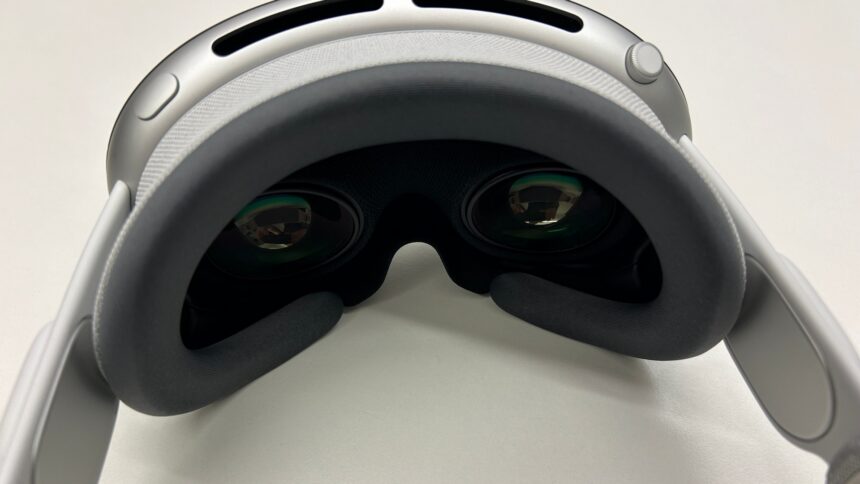
The OLED lenses on the Apple Vision Pro provide a narrower viewing angle compared to the Quest 3, but they are still of high quality.
The demonstration with dinosaurs, where I initially view a 3D world with dinosaurs through a screen and then witness them “invade” my room, is truly enjoyable. After that, I experienced Guardians of the Galaxy 3 in 3D on Disney Plus. It was impressive! The depth and clarity were outstanding! This is how I desire to watch my 3D movies in the future – it surpasses the cinema experience. Naturally, 2D movies and shows are also fantastic to watch on the clear, large virtual screen.
The field of view for the Vision Pro is noticeably smaller compared to the Quest 3. While I adapted to it quickly, I was somewhat disappointed.
Another cool feature is the Vision Pro’s so-called Digital Crown, which I can use to seamlessly switch between VR and Passthrough AR. The full VR environment is also crystal clear, making even the 3D-enhanced 360 home environments a feast for the eyes. On the other hand, these are still just 360 environments, not full 3D.
This is one of the main problems with the Vision Pro: almost everything is 2D, occasionally enhanced with some depth or 3D. I don’t feel that this is sufficient anymore, neither for Apple nor for Meta. Instead of simply translating analog concepts, i.e., flat screens, flat apps on flat smartphone displays and flat menus into XR, there should be more and above all real innovation. Immersive menus – when?
Why is there criticism towards the Vision Pro now? It is because Apple emphasizes the term “Spatial” extensively in its marketing, yet ultimately focuses on 2D content. This is quite disappointing.
Passthrough & AR (Mixed Reality)
The pass-through mode of the Vision Pro is superior to that of the Quest 3, although it is not flawless. In terms of technical comparison, the AVP’s color cameras boast a resolution of 6.5 megapixels, whereas the Quest 3’s resolution is limited to four megapixels. The view through the Vision Pro appears dim and its image quality is heavily reliant on lighting conditions, making it grainier in low light situations. Additionally, when moving your head from side to side, the image becomes significantly blurred, which can be quite bothersome. This phenomenon, known as motion blur, clearly gives the Quest 3 an advantage in this aspect.
Also, not great: When I fixate on tangible items like a desk or a cup on a table, the object appears to change in size and shape as I tilt my head up and down. This phenomenon occurs within certain boundaries, but it can be bothersome. While not overly disruptive, I can still observe chromatic aberrations at the periphery of the lenses.
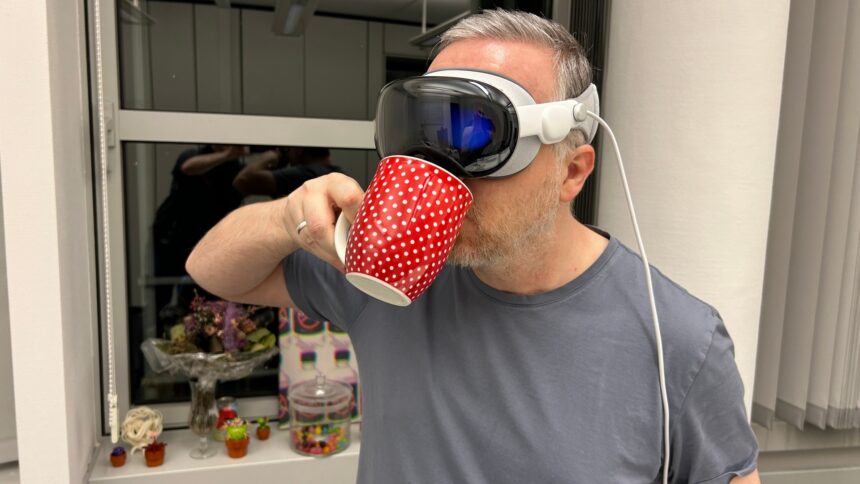
The Apple Vision Pro’s passthrough is good enough to carry out almost all daily activities. | Image: MIXED
However, my hands are now accurately shown without any delay or latency, which is a fantastic improvement compared to the Quest 3. When virtual objects are positioned behind or beneath my hand, I only see a small frame surrounding it, but there is no shaking or distortion like in the Quest 3. This is particularly beneficial when I need to use my smartphone while wearing the AVP. The visual quality of any physical screens is sharp and easy to read, with no distortions interfering with their usability.
Overall, the mixed reality mode is excellent, and the Vision Pro’s capability to position screens throughout the room and maintain their position even after leaving the room is another impressive feature.
When it comes to exiting the room, I can freely move around wearing the Vision Pro on my head without experiencing any delays. I can navigate without any limitations caused by latency, even in poorly lit spaces. I am able to securely hold onto a railing or ascend a staircase without encountering any delays.
Apple Vision Pro: Comfort
During extended use, the headset exerts pressure on the upper cheekbones despite its relatively light weight of approximately 650 grams.
The headband is intended to provide a comfortable fit, but it cannot be adjusted tightly enough for physical activity. When making quick movements with the head, the Vision Pro tends to slide back and forth on the head, even when the headband is tightened with significant pressure. It is evident that this is one of the reasons why Apple does not market the Vision Pro as suitable for fitness purposes.
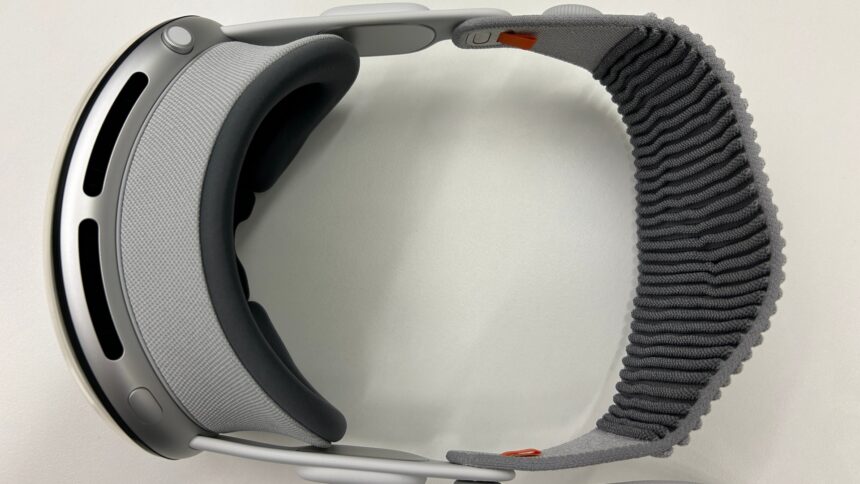
The front-heavy nature of the AVP is clearly evident here. The dual loop strap doesn’t change this.
The hastily designed “dual loop” head strap, likely designed in response to feedback from early testers, is completely useless. It cannot physically affect the balance of the VR/AR headset, the attachment point is too far back. A fundamental design flaw of the Vision Pro.
The face mask is made of fabric and fits my face perfectly, but is too thin for me. It may be possible to replace the face mask at some point with third-party accessories that provide slightly better cushioning than the official masks.
The Vision Pro does not accommodate glasses. The magnetic lenses for prescriptions are only accessible in the USA at the moment. If you wish to utilize the Vision Pro outside of the USA, you will need to wear contact lenses.
Battery, Sound, Software & Applications
The Vision Pro battery is linked to the Vision Pro using a cable and can be carried on the waist or in a pocket. It has a duration of around one hour and 45 minutes when operating at maximum pass-through, and over two hours in VR mode. While this is generally suitable for most purposes, it may pose an issue for extremely long movies unless the battery is simultaneously connected to a charger.
I discovered that the sound quality of the Vision Pro is excellent and has a rich tone. However, I can effortlessly connect and utilize my AirPods Pro.
The Vision Pro’s software offering is shockingly lacking for a hardware launch of this magnitude. After all, this is Apple’s first new product category in years. What’s more, it consists mainly of 2D apps from the iPad cosmos. This is a clear disadvantage compared to the Quest 3, which has a much wider range of VR games and apps available.
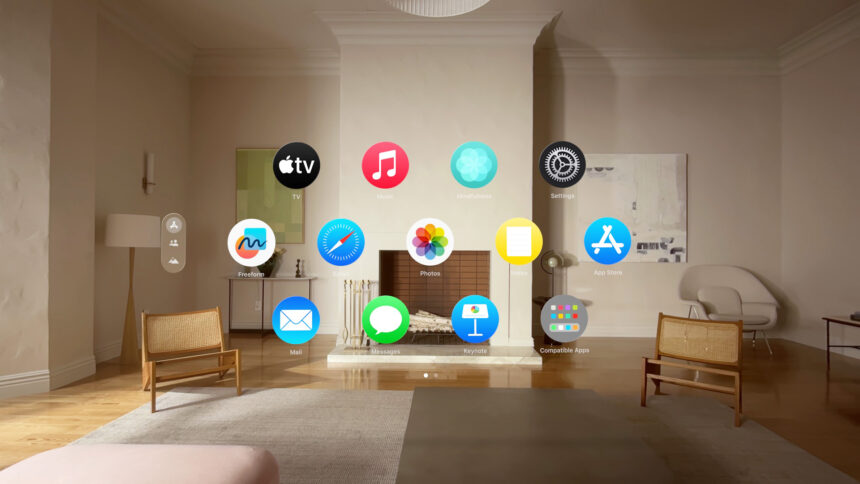
The Apple Vision Pro’s range of apps is significantly weaker than expected. | Image: Apple
To be fair, Meta also had a smaller selection of apps when it launched its Quest store. I’m curious to see if enough developers get excited about the Vision Pro in the coming months and years to fill the store with real, immersive applications.
I apologize for not being able to record spatial video due to lighting issues. I will provide an update on this matter in my review once we have the opportunity to use the Vision Pro consistently.
Spatial photos, on the other hand, are great because they offer depth, i.e., a 3D effect. However, they are also relatively small, which makes the effect less attractive than I would have liked. I’m really looking forward to further developments in this area and can’t wait to be able to walk around in a real “spatial photo”.
I am optimistic that virtual journeys will soon become a reality, such as visiting a friend’s living room. Personas, which are lifelike avatars currently utilized in FaceTime calls and similar platforms, play a significant role in progressing towards this goal. Contrary to numerous critics and online opinions, I personally believe that personas are not inherently negative, even if they have their imperfections. I have confidence that they will continue to improve over time.
Mac link, productivity
Finally, let’s talk about productivity. In my opinion, in the broadest sense of office work, Apple Vision Pro is only suitable for die-hard fans who are up to their necks in Apple’s ecosystem. And even though Internet celebrities have already publicly announced the sale of their physical monitors, I doubt that this will really be a thing anytime soon.
When I own a Mac, a virtual “Connect” button appears above it, which is pretty awesome. Upon selecting it, the Mac establishes a direct connection with the Vision Pro. This is fantastic, as it perfectly demonstrates how it operates, Meta!
However, the following sequence of events is absurd: when connecting to the Mac, the Mac screen is deactivated and projected as a virtual screen in the room. Input is still required through the Mac keyboard. In my experiments, using the Mac screen simultaneously with other virtual screens was not successful. In fact, only one virtual Mac screen can be utilized. This design flaw is extremely inefficient, and Meta’s Horizon Workrooms performs much better in comparison. This is one of the factors hindering the Vision Pro from being suitable for productive tasks (at least for now), especially considering the limitations in battery life as well.
Furthermore, if an app is not compatible with the iPad, it cannot be used on the Vision Pro. I attempted to find Mac apps without success, and there are no Adobe tools for editing images and videos. Additionally, coding apps are unavailable. It is important to note that the Vision Pro is equipped with an advanced M2 processor. However, the absence of numerous popular productivity apps does not adequately justify the high price of the device.
The Vision Pro may revolutionize the field of 3D object display (visualization and design) and, to some extent, training. Previously, achieving this level of clarity and performance with pass-through AR required costly VR headsets like Varjo and a computer. However, now you can accomplish it independently with excellent quality.
Eye-Sight
One of the most eye-catching features should be Eye-Sight, a “reverse pass-through image” of the wearer’s eyes on the front display. What can I say: I’m not convinced. It’s nowhere near the promotional videos, and the reflection of the environment on the black, shiny front surface often obscures the Eye-Sight effect.
In my situation, there were instances when my eyes appeared lower than usual, resulting in some amusement with my colleague Jan.
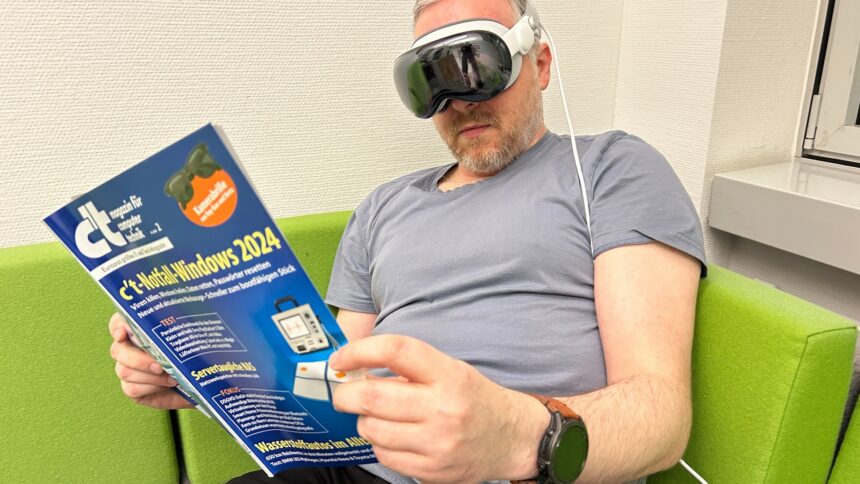
The idea of using eye-sight as a social interaction tool seems promising in theory, but it is not yet fully developed in practice. | Image: COMBINED
I comprehend the underlying intention of achieving greater social approval through the ability to establish visual connection, but I remain unconvinced. Personally, I view this characteristic as more of an experimental aspect and therefore perceive it as somewhat pointless.
Apple Vision Pro and privacy
Apple, similar to other technology companies, gathers information from individuals who use their products. This encompasses the spatial data obtained through the cameras and sensors of the Vision Pro device.
Apple has a good reputation when it comes to privacy, but ultimately, it is a matter of trust whether you want to share your data with the company. In its policies, Apple – like Meta & Co – states how it claims to use and protect the data.
Users have to decide for themselves. Personally, I have no problem with sharing my data as long as it stays with the company and is not sold.
The review of Apple Vision Pro shows progress, but there is still much room for improvement.
The Apple Vision Pro is a remarkable VR/AR headset that establishes new benchmarks in various aspects. Its exceptional image quality, accurate and responsive hand- and eye-tracking, along with the mostly excellent pass-through functionality, make it stand out.
In general, Apple falls short in delivering impressive features. The Vision Pro is overly expensive for regular users as it does not offer enough valuable content to justify the steep cost. Additionally, it is merely a standard projection screen for 2D applications, lacking innovation. After thoroughly testing it, I had experienced everything that was important, leaving me feeling greatly disappointed.
The question is: What should I do with this costly advanced gadget?
If I received the Vision Pro as a gift, I would sometimes enjoy watching 3D movies as I believe it is a superior experience compared to going to the cinema. However, I can only watch them alone. It is not feasible to watch the same movie with multiple people wearing AVPs in pass-through mode.
In conclusion, I can only state that the Vision Pro represents a significant advancement towards a more immersive future. However, it is evident that there is still a considerable distance to cover. The shortage of well-crafted content that truly captivates users remains a challenge. Likewise, there is a noticeable absence of groundbreaking innovation, particularly in terms of fully immersive menus.
Meta has partially an advantage here with its focus on gaming and fitness applications. Apple’s future strategy will show whether this will remain the case. Vision Pro currently takes the vision of “spatial computing” a step further, but does not develop it sufficiently and is therefore far from being Pro.






